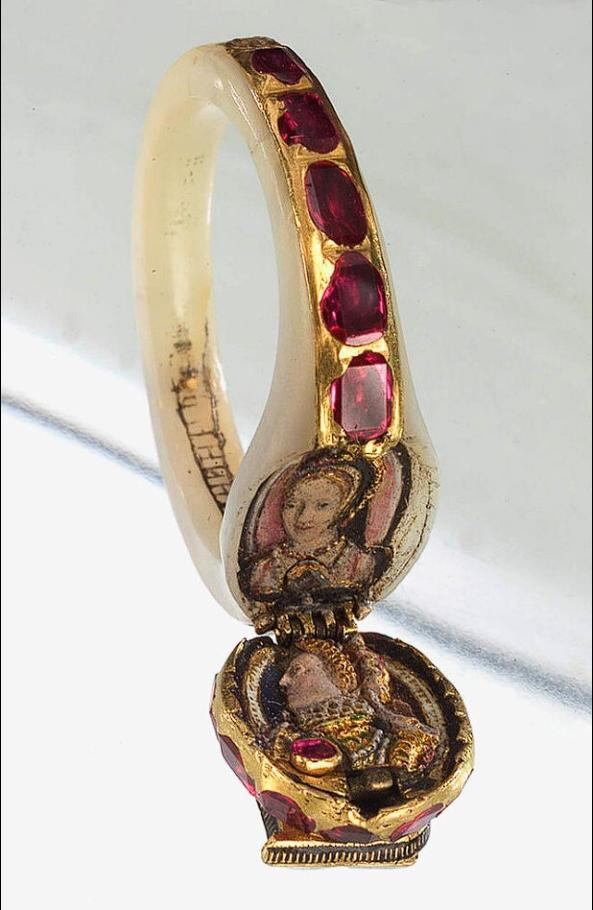“The Chequers Ring, a delicate and intricately crafted piece of jewelry, stands as a poignant testament to the private world of Queen Elizabeth I. Beyond its exquisite mother-of-pearl, rubies, and diamonds, the ring holds a secret compartment, revealing miniature portraits that speak volumes about Elizabeth’s personal loyalties and the complex emotions surrounding her lineage. This artifact, reportedly worn by the queen until her death, serves as a powerful symbol of her enduring connection to her mother, Anne Boleyn, and a quiet declaration of her identity amidst the political turmoil of her reign.”
A Royal Secret: Unveiling the Ring’s Intimate Details
- Craftsmanship and Symbolism:
- The Chequers Ring, crafted with meticulous detail, is more than just a piece of royal jewelry. Its materials and design reflect the wealth and sophistication of the Elizabethan court, while its hidden compartment reveals a deeply personal narrative.
- The use of mother-of-pearl, rubies, and diamonds, each chosen for their beauty and value, underscores the ring’s significance as a symbol of royal power. However, the true meaning lies in the hidden portraits, transforming it into a personal keepsake.
- Hidden Portraits: A Mother-Daughter Bond:
- The ring’s hidden compartment contains two miniature portraits: one of Queen Elizabeth herself, depicted in her regal style, and the other, believed to be of her mother, Anne Boleyn.
- The inclusion of Anne Boleyn’s portrait, a woman executed when Elizabeth was just a toddler, speaks volumes about Elizabeth’s private emotions. Given the political danger of publicly acknowledging her disgraced mother, this hidden tribute reveals the depth of their bond.
- A Quiet Declaration:
- The ring, reportedly worn by Elizabeth until her death, suggests it served as more than just a personal keepsake. It may have also functioned as a quiet declaration of her identity and lineage, a subtle assertion of her connection to a mother whose downfall had once threatened her own future.
- This act of wearing the ring, a constant reminder of her mother, can be seen as an act of defiance, a quiet rebellion against the political forces that sought to erase Anne Boleyn from history.
A Legacy of Loyalty: Navigating Political Turmoil
- Anne Boleyn’s Shadow:
- Anne Boleyn’s execution cast a long shadow over Elizabeth’s early life. The political circumstances surrounding her mother’s downfall were fraught with danger, threatening Elizabeth’s own legitimacy and survival.
- Growing up in the shadow of her mother’s disgrace, Elizabeth learned to navigate the treacherous waters of the Tudor court, developing a keen sense of political strategy and self-preservation.
- Political Implications:
- Publicly acknowledging her connection to Anne Boleyn would have been a politically risky move for Elizabeth. The memory of her mother was a source of controversy and could have been used against her by her enemies.
- The hidden portraits in the Chequers Ring, therefore, represent a private act of defiance, a way for Elizabeth to honor her mother without jeopardizing her own position.
- Enduring Connection:
- Despite the political risks, Elizabeth chose to keep her mother’s portrait close, wearing the ring throughout her life. This act underscores the enduring connection between mother and daughter, a bond that transcended political circumstances.
- The ring, therefore, becomes a symbol of Elizabeth’s personal loyalty, a testament to the enduring power of familial love in the face of adversity.
Historical Significance: Unraveling a Queen’s Inner World
- Insights into Elizabeth’s Character:
- The Chequers Ring provides valuable insights into Elizabeth’s character, revealing her private emotions and loyalties. It shows a side of the queen that is often hidden behind her public persona, a woman capable of deep affection and enduring memory.
- This artifact humanizes Elizabeth, reminding us that behind the regal facade was a woman with complex emotions and personal connections.
- Historical Context:
- The ring’s significance is heightened by the historical context of Elizabeth’s reign. The political turmoil and religious conflicts of the Tudor era shaped her life and decisions, making her private expressions of loyalty even more meaningful.
- Understanding the political landscape of Elizabeth’s time allows us to appreciate the courage and significance of her quiet tribute to her mother.
- A Legacy of Remembrance:
- The Chequers Ring serves as a lasting legacy of remembrance, a tangible connection to a queen who navigated a tumultuous period with remarkable strength and resilience. It reminds us of the enduring power of familial bonds and the importance of honoring one’s heritage.
- This artifact, therefore, transcends its material value, becoming a symbol of enduring love and a testament to the complex legacy of Queen Elizabeth I.
Conclusion:
“The Chequers Ring, with its hidden portraits and intricate design, stands as a profound artifact, offering a glimpse into the private world of Queen Elizabeth I. It is a testament to her enduring connection to her mother, Anne Boleyn, and a symbol of her quiet defiance against the political forces that sought to erase her lineage. This ring, worn until her death, serves as a poignant reminder of the enduring power of familial love and a lasting legacy of a queen who navigated a treacherous era with unwavering strength and determination.”

CÁC TIN KHÁC
Mary Walton: The Forgotten Inventor Who Helped Clean Up America’s Cities
Tomb of Queen Nefertari in the Valley of the Queens, Egypt
Discover the Hypostyle Hall of the Temple of Hathor at Dendera
Venus de Losange: Unveiling the Mystery of a 20,000-Year-Old Paleolithic Icon